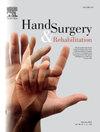在WALANT下,顺行超声引导肘部纤维撕脱术-技术要点。
IF 1
4区 医学
Q4 ORTHOPEDICS
引用次数: 0
摘要
动态压迫肘部纤维束肌下的正中神经会引起疼痛和虚弱。这是一种经常被忽视的病理,也是腕管释放后恢复失败的原因。目的是介绍在WALANT下微创超声引导下的切口综合征手术治疗的技术要点。我们认为,该技术适用于表现为裂口正中神经Hagert三联征阳性,拇长屈肌、指深第二屈肌和桡侧腕屈肌无力,以及敏感塌陷试验阳性的患者。禁忌症包括肘部静态正中神经压迫和对利多卡因过敏。该技术在局部麻醉之前,在超声引导下完成更深或更近端的结构。进入点计算为靠近撕裂肌,特殊刀通过0.5厘米的切口引入。在超声引导下顺行切开裂口。完全恢复的实力是完成分割的证明。患者在手术后几天到一周内恢复完全活动。微创,超声引导释放允许快速恢复全力量运动,最小的疤痕。本文章由计算机程序翻译,如有差异,请以英文原文为准。
Anterograde ultrasound guided lacertus fibrosus release at the elbow under WALANT – Technical note
Dynamic compression of the median nerve under the lacertus fibrosus at the elbow causes pain and weakness. It is a frequently overlooked pathology and a cause of failed recovery after carpal tunnel release.
The purpose was to present a technical note on minimally invasive ultrasound-guided lacertus syndrome surgical treatment under WALANT.
We believe the technique is indicated in patients who present with a positive Hagert's triad of pain over the median nerve at the lacertus, weakness on testing of the flexor pollicis longus, second flexor digitorum profundus, and flexor carpi radialis, and a positive sensitive collapse test. Contraindications include static median nerve compression at the elbow and allergy to lidocaine.
The technique is preceded by local anesthesia, which is completed under ultrasound guidance for deeper or more proximal structures. The entry point is calculated proximal to the lacertus and the special knife is introduced through a 0.5 cm incision. The lacertus is divided anterogradely under ultrasound guidance. Full recovery of strength is evidenced by the completion of the division.
The patient returns to full activity within days to a week after surgery.
Minimally invasive, ultrasound-guided release allows for rapid return of full-strength motion with minimal scarring.
求助全文
通过发布文献求助,成功后即可免费获取论文全文。
去求助
来源期刊

Hand Surgery & Rehabilitation
Medicine-Surgery
CiteScore
1.70
自引率
27.30%
发文量
0
审稿时长
49 days
期刊介绍:
As the official publication of the French, Belgian and Swiss Societies for Surgery of the Hand, as well as of the French Society of Rehabilitation of the Hand & Upper Limb, ''Hand Surgery and Rehabilitation'' - formerly named "Chirurgie de la Main" - publishes original articles, literature reviews, technical notes, and clinical cases. It is indexed in the main international databases (including Medline). Initially a platform for French-speaking hand surgeons, the journal will now publish its articles in English to disseminate its author''s scientific findings more widely. The journal also includes a biannual supplement in French, the monograph of the French Society for Surgery of the Hand, where comprehensive reviews in the fields of hand, peripheral nerve and upper limb surgery are presented.
Organe officiel de la Société française de chirurgie de la main, de la Société française de Rééducation de la main (SFRM-GEMMSOR), de la Société suisse de chirurgie de la main et du Belgian Hand Group, indexée dans les grandes bases de données internationales (Medline, Embase, Pascal, Scopus), Hand Surgery and Rehabilitation - anciennement titrée Chirurgie de la main - publie des articles originaux, des revues de la littérature, des notes techniques, des cas clinique. Initialement plateforme d''expression francophone de la spécialité, la revue s''oriente désormais vers l''anglais pour devenir une référence scientifique et de formation de la spécialité en France et en Europe. Avec 6 publications en anglais par an, la revue comprend également un supplément biannuel, la monographie du GEM, où sont présentées en français, des mises au point complètes dans les domaines de la chirurgie de la main, des nerfs périphériques et du membre supérieur.
 求助内容:
求助内容: 应助结果提醒方式:
应助结果提醒方式:


